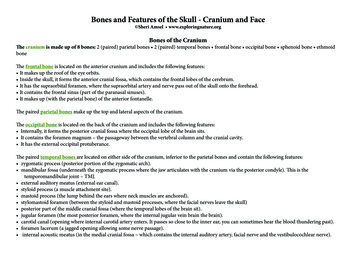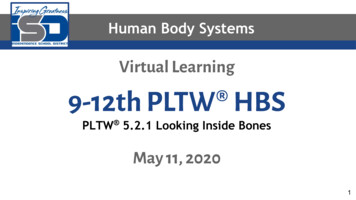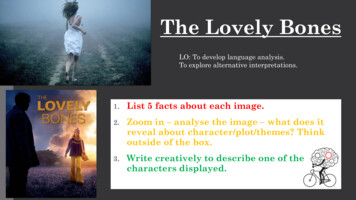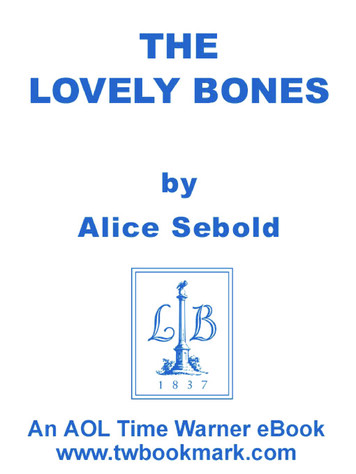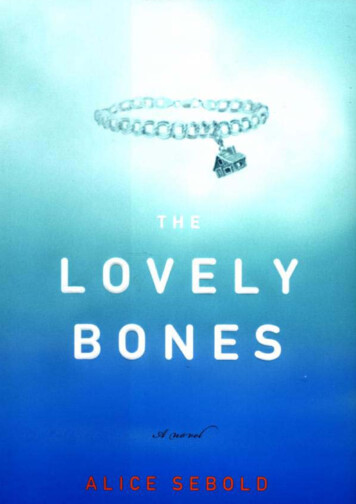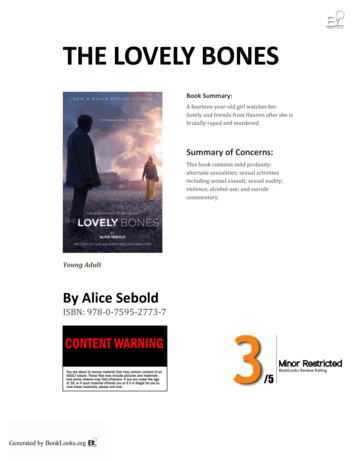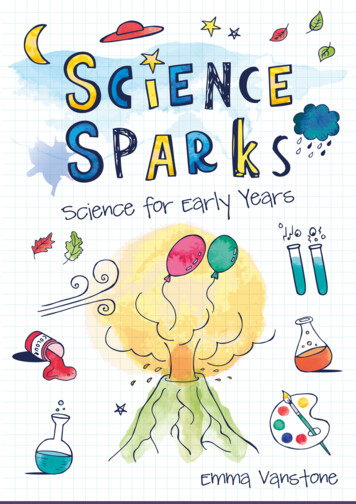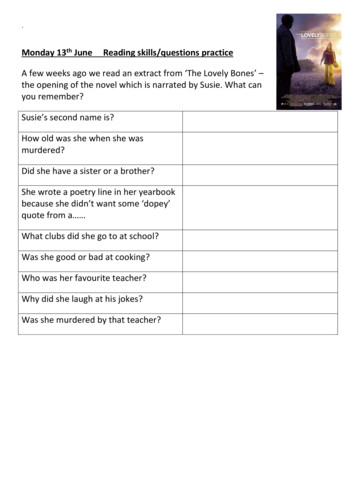
Transcription
.Monday 13th JuneReading skills/questions practiceA few weeks ago we read an extract from ‘The Lovely Bones’ –the opening of the novel which is narrated by Susie. What canyou remember?Susie’s second name is?How old was she when she wasmurdered?Did she have a sister or a brother?She wrote a poetry line in her yearbookbecause she didn’t want some ‘dopey’quote from a What clubs did she go to at school?Was she good or bad at cooking?Who was her favourite teacher?Why did she laugh at his jokes?Was she murdered by that teacher?
.Let’s check our answers:My name was Salmon, like the fish; first name, Susie. I was fourteen when I was murdered on December 6,1973. In newspaper photos of missing girls from the seventies, most looked like me: white girls withmousy brown hair. This was before kids of all races and genders started appearing on milk cartons or inthe daily mail. It was still back when people believed things like that didn't happen.In my junior high yearbook I had a quote from a Spanish poet my sister had turned me on to, Juan Ram'nJim'nez. It went like this: "If they give you ruled paper, write the other way." I chose it both because itexpressed my contempt for my structured surroundings ' la the classroom and because, not being somedopey quote from a rock group, I thought it marked me as literary. I was a member of the Chess Club andChem Club and burned everything I tried to make in Mrs. Delminico's home ec class. My favourite teacherwas Mr. Botte, who taught biology and liked to animate the frogs and crawfish we had to dissect bymaking them dance in their waxed pans.I wasn't killed by Mr. Botte, by the way. Don't think every person you're going to meet in here is suspect.That's the problem. You never know. Mr. Botte came to my memorial (as, may I add, did almost the entirejunior high school-I was never so popular) and cried quite a bit. He had a sick kid. We all knew this, sowhen he laughed at his own jokes, which were rusty way before I had him, we laughed too, forcing itsometimes just to make him happy. His daughter died a year and a half after I did. She had leukemia, but Inever saw her in my heaven.Let’s recap the impression we got of Susie in this opening extract:How does Susie come across to you? Which adjectives could you use to describeher? .Is she likeable – would you/most people like her? Yes, no, why? . .Does she sound like a typical teenager? Yes, no, why? . Does she sound like a typical teenager? Yes, no, why? . .Does she have anything in common with you? Does she sound like she deserves to be murdered? Now we’re going to read another section of The Lovely bones – also from the start,following on from that first part. We’re practising the skill of thinking as we read : formingopinions and impressions – nail that skill and the questions become easier.
.Lovely Bones extract 2:My murderer was a man from our neighbourhood. My mother liked his border flowers, and my father talkedto him once about fertilizer. My murderer believed in old-fashioned things like eggshells and coffee grounds,which he said his own mother had used. My father came home smiling, making jokes about how the man'sgarden might be beautiful but it would stink to high heaven once a heat wave hit.But on December 6, 1973, it was snowing, and I took a shortcut through the cornfield back from the juniorhigh. It was dark out because the days were shorter in winter, and I remember how the broken cornstalksmade my walk more difficult. The snow was falling lightly, like a flurry of small hands, and I was breathingthrough my nose until it was running so much that I had to open my mouth. Six feet from where Mr. Harveystood, I stuck my tongue out to taste a snowflake. "Don't let me startle you," Mr. Harvey said. Of course, ina cornfield, in the dark, I was startled. After I was dead I thought about how there had been the light scent ofcologne in the air but that I had not been paying attention, or thought it was coming from one of the housesup ahead."Mr. Harvey," I said. "You're the older Salmon girl, right?" "Yes." "How are your folks?"Although the eldest in my family and good at acing a science quiz, I had never felt comfortable with adults."Fine," I said. I was cold, but the natural authority of his age, and the added fact that he was a neighbour andhad talked to my father about fertilizer, rooted me to the spot."I've built something back here," he said. "Would you like to see'" "I'm sort of cold, Mr. Harvey," I said,"and my mom likes me home before dark.""It's after dark, Susie," he said.I wish now that I had known this was weird. I had never told him my name.1. Question 2 skills practice: Look at the second paragraph again. How does the writer uselanguage to present the moment Susie meets Mr Harvey?THINK FIRST: What time of day is it? What’s described about the cornfield? .What simile is used to describe the snow? .What does Susie do to taste a snowflake? How does this behaviour make her seem – childish or adult-like? How close is she to Mr Harvey without knowing it? .2. When you’ve answered the questions, highlight where you found the answers in theextract.
.3. Look at what you’ve highlighted – can you identify a word type/sentencetype/technique? Annotate it e.g. dark, dark – adjective, repetition4. Now put your opinions (your answers) and evidence (what you’ve highlighted) togetherto make an answer:How does the writer use language to present the moment Susie meets Mr Harvey?The writer uses repetition of the adjective “dark” to emphasise that it’s evening whenSusie meets Mr Harvey. This makes the moment more tense as Susie is only avulnerable child and should probably be home and there’s also no reason for Mr Harveyto be out in a cornfield at that time. It gives me the impression that he’s been waitingfor her which is creepy and dangerous.The writer also . . . . . . . . . . . 5. Question 3 skills practice: Look at the whole extract again. How has the writerstructured the text to interest the reader?THINK first: the first paragraph is about .Gardening and fertiliser – ordinary or extraordinary things? .The second paragraph – little detail or lots of detail? .Detail about what? .What does the reader learn about Mr Harvey BEFORE he speaks? . .
.The end section of the extract is the conversation between Susie and Mr Harvey. Who’s incontrol of that conversation? How can you tell? . .What about the final line? What sort of atmosphere does that end the extract on? Why? .6. Now put your opinions (your short answers) together to make an answer: How has thewriter structured the text to interest you as a reader?The extract starts Susie explaining who ‘my murderer’ was, throughdescribing a conversation about gardening and fertiliser. This is an eeriestart because the readers know that Susie’s parents knew the man who killedtheir daughter which suggests he might have watched and targeted her for along time.In the second paragraph the writer describes . . . . . . . . . .
.7. Using the mats to help you, mind-map phrases (or go straight into writing a paragraph ifyou prefer) that could describe a dark, deserted field in a creepy way. It could besummer or winter. There could be sounds, movement. Include how your body wouldreact to the place/any sounds. . . . . . . . . . . Finally CHECK your work – capitals, full stops, apostrophes .Have a go at marking your work – ask me for a mark-scheme and see what you think yourwork would achieve! (I’ll mark it after you)
Lovely Bones extract 2: My murderer was a man from our neighbourhood. My mother liked his border flowers, and my father talked to him once about fertilizer. My murderer believed in old-fashioned things like eggshells and coffee grounds, which he said his own mother had used. My father came home smiling, making jokes about how the man's

